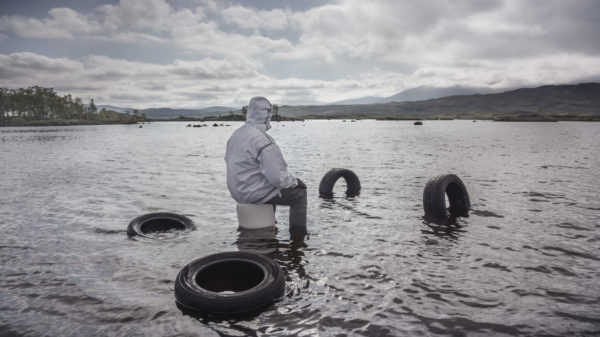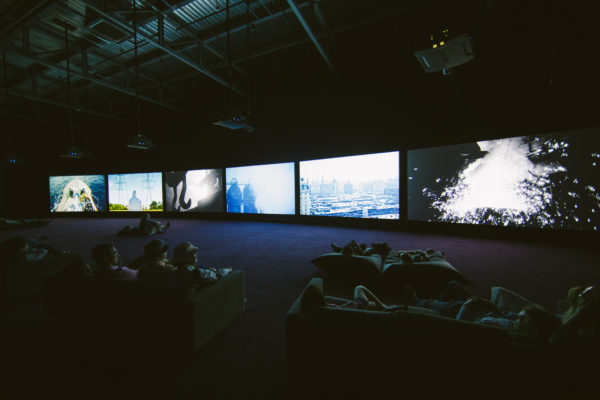Visual Arts Review: The ICA’s Watershed Points to How We Got Here
By Lena Novins-Montague
Purple is an ambitious, over-the-top endeavor, which feels completely appropriate, given the calamity at hand.
Purple at the ICA Watershed in Boston, MA, through September 2.

John Akomfrah, “Purple,” 2017. Six-channel HD color video installation with 15.1 surround sound; 62 minutes. Courtesy Lisson Gallery. © Smoking Dogs Films.
Are artists responsible, particularly given the rising crisis of global warming, for bringing light to issues of social importance? For artist John Akomfrah, the answer is a resounding yes. His current exhibition Purple boldly prods and points at questions of climate change, race, and gender.
The vehicle is an all-encompassing video installation, which at times slaps us over the head with its didactic message, before retreating back into more abstract, demure moments. It’s an ambitious, over-the-top endeavor, which feels completely appropriate, given the subject matter.
Purple’s exhibition space, the ICA Watershed, is a spare and airy outpost that was unveiled last year in the Boston Harbor Shipyard. Its location makes it a particularly salient place to house art about climate change. A map in the museum projects what the Boston Harbor will look like in the coming decades, if global warming continues at its current rate. The prediction is grim. By the year of 2070, large swaths of Boston, including the Shipyard, are likely to be underwater.
While this visual aid may lead the viewer to think Purple will focus on our backyard, the expectation is shattered within moments of taking in the centerpiece of the project, an hour-long film that unfolds on six different screens in a curved theatre. Akomfrah combines hundreds of hours of archival footage with newly shot film, which was gathered from eleven different climate-sensitive locations, ranging from Alaska to the Marquesas Islands in French Polynesia to Wales.
Despite the global reach, the project remains deeply personal. Akomfrah, who is originally from Ghana and grew up in East London, has constructed Purple with his own experience as a foundation. “It’s about saying to yourself and a viewer, I don’t have to be an expert to speak about quote unquote ‘scientific things.’ It felt important to try and bring together questions of climate change with global inequalities, which have other histories, colonial and so on…And I don’t feel I’m an outsider to it,” Akomfrah explained in an interview with the Barbican Centre.
The film begins with power plants and a close-up of water rushing over rocks in a stream. Soon, these rocks are layered with photographs of children. This river is a motif, and we’ll return to it again and again to see what’s disrupting the flow of the water. Hint: it’s ourselves.
Two simultaneous births follow. This may not be a cliche-free way to kick off a cycle, but Akomfrah sharpens his message by placing two birth-giving experiences, one in a seemingly developed country and the other in a developing country, side by side. The comparative method continues throughout the film, as contrasting universes appear next to each other. We’re transported to the peaks of Alaska, where men scale mountains. On adjacent panels, black and white adults dance separately, divided by a rope.
Time is bendy. Grainy black-and-white footage is displayed beside fresh, high quality shots. Every time it feels as if Purple may be making a permanent leap forward in time, it brings us back in time to when our problems began.
On an aesthetic level, the exhibition is ridiculously entertaining to absorb. The palette is shocking and the scale is so great that some neck craning is inevitable. The artistry draws us in even further, which increases our receptivity to what Purple is trying to say to us.

Installation view of “Purple.” Photo: Meg Elkinton.
At times, this message of planetary breakdown comes off as cloying. The black-and-white shots of human-caused destruction juxtaposed with rolling green hills are punctuated by a score that grows increasingly ominous and unnecessary. On the other hand, maybe scare tactics may still be useful in a culture mired in denial. Nothing else seems to be working any better.
Perhaps Purple is most successful during its absurd moments of over-the-top horror, effective because they are so rare. When Akomfrah turns away from his BBC’s Planet Earth-style shots (which are lovely to look at, but nothing new) he leans into his cinematic impulses, and these are the kooky moments that stick and make this project a brain-teaser. The image of a woman sitting at a dining room table robotically eating the head of a man is brief, but it’s one you’re not likely to miss.
Purple ends exactly how you would imagine: by coming full circle. And this, too, can feel a bit contrived, until you take another look at that map outside the theater. There’s only one way this multi-pronged story ends — and it’s not going to be pretty.
Lena Novins-Monauge is a senior at Tufts University where she studies English and Political Science. She is also the Editor-in-Chief of the Tufts magazine, the Tufts Observer. Most recently, she completed an editorial internship while studying abroad in Buenos Aires, Argentina, at a lifestyle and culture publication. She is interested in multimedia art, contemporary poetry, and the intersection of politics and art.
Tagged: Institute of Contemporary Art, John Akomfrah, Lena Novins-Montague
